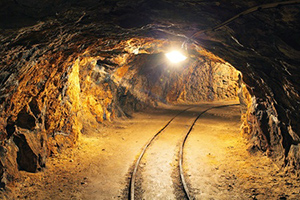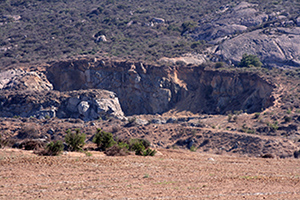Illegal mining is on the rise in South Africa and presents challenges that need to be addressed from a range of perspectives. At the end of September, the Chamber of Mines and Mine Rescue Services (MRS) once again raised the issue on the R6-billion/year illegal mining sector, saying that it is spiralling out of control with recorded incidents being the tip of the iceberg.
Although this article focuses mainly on the larger mining industry, illegal mining is also a major issue in the quarrying sector, offering up many similar challenges. These include a loss of revenue, taxes, employment opportunities, capital expenditure and procurement generally led by legal mining entities.
According to Mine Rescue Services CEO Christo de Klerk, 90% of illegal underground incidents are unreported, and the organisation only receives reports or responds to 10% of these.
 The Zama-Zamas enter the shafts, travelling as far as 4,0 km underground, where they live for several days at a time, risking their lives for an income.
The Zama-Zamas enter the shafts, travelling as far as 4,0 km underground, where they live for several days at a time, risking their lives for an income.
The challenges related to illegal mining are significant and a very recent tragedy was the illegal miners trapped in difficult and very dangerous circumstances in an abandoned mine in Langlaagte, south of Johannesburg. The MRS was involved in the rescue attempt for these individuals but the search was eventually called off with some Zama-Zamas remaining buried underground.
At that time, the Daily Maverick’s Bheki Simelane reported that after working through the night to rescue the trapped miners from the disused mine, Johannesburg Emergency Services (JES) had suspended the search. This after two illegal miners who had been underground for several days were brought to surface; one alive and one dead. The day’s highlight was at about 11:00 when two dust-coated figures emerged from the mine entrance, looking fairly strong considering that they had been holed up for two weeks underground.
One of these illegal miners was 17-year old Jeremiah Sithole and he and his older companion carried sacks of gold product on their backs. Sithole and his older more experienced friend both hail from Tembisa, and were not aware that other Zama-Zamas had died in the same mine.
Illegal mining is a very serious challenge in South Africa; it is dangerous with illegal miners risking their lives to open cemented shafts with explosives on abandoned mines. These miners enter the abandoned shafts, travelling as far as 4,0 km underground, where they live for several days at a time, risking their lives for an income.
The surge in illegal mining is two-pronged:
• South Africa’s socio-economic environment is troubled; there is an increase in unemployment, poverty and the entry of large numbers of illegal immigrants into the country.
• It was initially based on the surge in the gold price during the bull market of the first decade of this century. Despite the fall in the US$ gold price since 2011, the rand gold price has held sufficiently steady to keep illegal mining profitable.
• There are limited resources at the disposal of law enforcement agencies to stem illegal mining, such as police, immigration, border controls and prosecuting authorities.
According to the Chamber of Mines, 70% of all arrested illegal miners are illegal immigrants.
Illegal mining is often organised and carried out by organised crime syndicates. The Zama-Zamas are often heavily armed and where trespassing on operating mines, set ambushes and booby traps for employees, security and rival groups of illegal miners.
Because they are serving organised criminal bosses, the miners taking these risks are not seeing the real value of their labour.
The illegal mining market is a well-managed five-tier system:
• 1st Tier: The underground workers, most illegal immigrants do the physical mining. Many have worked in the mines previously. They use chemical substances to primitively refine the product.
• 2nd Tier: The buyers on the surface around the mines. They also organised the level one illegal miners and support them with food, protection and equipment.
• 3rd Tier: The regional bulk buyers who usually are entities which, in most cases, have permits issued in terms of the Precious Minerals Act to trade in precious metals.
• 4th Tier: Those who distribute nationally and sometimes internationally, through front companies or legitimate exporters.
• 5th Tier: The top international receivers and distributors, usually through international refineries and intermediary companies.
The Chamber has recognised that the only way to deal with the problem is to focus on both the supply and demand side of illegal mining, ie, all five levels of the syndicates need to be addressed.
While local police and mine security deal with level ones and twos, the Chamber of Mines, the South African Police Service, the National Coordinating Strategic Management Team and the Department of Mineral Resources are working to identify and deal with the level threes, fours and fives that constitute the buyer market. This work is undertaken hand-in-hand with international agencies such as the United Nations Interregional Crime and Justice Research Institute, European police, Interpol and international embassies.
The Chamber of Mines has a long-established Standing Committee on Security, where its members deal with all issues relating to security and product theft at mines. The Standing Committee on Security led the establishment of the multi-stakeholder National Precious Metals Forum over a decade ago. The NPMF consisted of representatives of mining companies, the Chamber of Mines, South African Police Service (various branches in the forensic science laboratory), the South African Precious Metals and Diamonds Regulator, Rand Refinery and the National Prosecuting Authority.
Illegal mining has a range of negative social and financial impacts:
• Many illegal miners have lost their lives in accidents, often being buried alive.
• They tend to use extremely environmentally-unfriendly and unhealthy refining methods.
• Where they trespass on operating mines to do their work, it results in loss of revenue, taxes, employment opportunities, capital expenditure, exports, foreign exchange earnings and procurement generated by legal mining.
• Mining communities suffer as they become riddled with related crime such as bribery, violence against workers and management, and child labour.
No single stakeholder can address the challenge of illegal mining on its own and collaboration is key, both from the large mining industry and the aggregate and sand sector. The Aggregate and Sand Producers Association of Southern Africa (Aspasa) puts in a lot of effort and hard work towards ensuring that member companies are compliant with local legislation, and able to measure themselves against international standards for environmental protection and sustainability.
Yet despite Aspasa’s effort to formalise and professionalise the industry, illegal quarrying and borrow pits are still proliferating, threatening waterways and making vast tracts of land unusable for future generations. While Aspasa member companies spend a lot of time and revenue on ensuring compliance, informal operations have no such worry and simply do as they please to the environment, impacting on local communities and the environment.
 Despite Aspasa’s effort to formalise and professionalise the industry, illegal quarrying and borrow pits are still proliferating, threatening waterways and making vast tracts of land unusable for future generations (photo Dale Kelly).
Despite Aspasa’s effort to formalise and professionalise the industry, illegal quarrying and borrow pits are still proliferating, threatening waterways and making vast tracts of land unusable for future generations (photo Dale Kelly).
Borrow pits run by municipalities, road building operations and other organisations do not fare much better and are held to far less vigorous requirements. However, the end result of polluted waterways or scarred environments are devastating and should not be encouraged nor should aggregates unearthed in such a manner ever be used on sites anywhere in South Africa.
Aspasa director Nico Pienaar says that in the last decade especially, the quarrying industry under direction of the Association has undergone a massive transformation from an essentially unregulated free-for-all to a stage where it is among the leaders worldwide when it comes to human and environmental issues.
“Our About Face Environment Programme for continual environmental performance improvement guides and measures our members to perform according to international standards. If they don’t, they are given a chance to take corrective action; if they do not then comply they cannot be members of Aspasa.
“As a result quarries belonging to Aspasa are required to have far-reaching environmental plans that span from planning and conception of the quarry, through its operation and entire lifecycle through to the rehabilitation and eventual closure of the quarry. In addition, land use plans that extend well beyond the operational life of the quarry are also being drawn up to ensure that surrounding communities are not left with a scar, but rather with a positive and enriching legacy for the future,” Pienaar says.
“For this reason we urge the road building community, municipalities, government departments and construction companies to only procure sand and aggregates from compliant members that are members of Aspasa and that have undertaken to protect the environment and give back to surrounding communities. Aspasa quarries subscribe to being accountable, transparent and credible and it pays to support companies that are looking after our future.
“We are all citizens of this country and our actions today will have a direct impact on our children and their children for years to come. We sincerely hope that the next time decision makers specify materials for construction sites that they insist of aggregates being procured only from Aspasa-accredited quarries,” he adds.
Report by Dale Kelly





